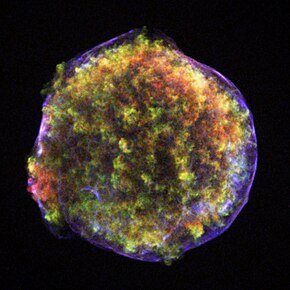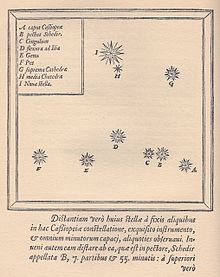SN 1572
 | |
| Event type | Astronomical radio source,astrophysical X-ray source |
|---|---|
| Type Ia[1] | |
| Date | November 1572 |
| Constellation | Cassiopeia |
| Right ascension | 0h25.3m |
| Declination | +64° 09′ |
| Epoch | ? |
| Galactic coordinates | G.120.1+1.4 |
| Distance | between 8,000ly(2.5kpc) and 9,800 ly (3 kpc) |
| Remnant | Nebula |
| Host | Milky Way |
| Progenitor | Unknown |
| Progenitor type | Unknown |
| Colour(B-V) | ~1 |
| Peakapparent magnitude | −4 |
| Other designations | SN 1572, HR 92, SN 1572A, SNR G120.1+01.4, SNR G120.2+01.4, 1ES 0022+63.8, 1RXS J002509.2+640946, B Cas, BD+63 39a, 8C 0022+638, 4C 63.01, 3C 10, 3C 10.0, 2C 34, RRF 1174, 1XRS 00224+638, 2U 0022+63, 3A 0022+638, 3CR 10, 3U 0022+63, 4U 0022+63, AJG 112, ASB 1, BG 0022+63, CTB 4, KR 101, VRO 63.00.01, [DGW65] 3, PBC J0024.9+6407, F3R 3628, WB 0022+6351, CGPSE 107, GB6 B0022+6352 |
| Preceded by | SN 1181 |
| Followed by | SN 1604 |
SN 1572(Tycho's Supernova,Tycho's Nova), orB Cassiopeiae(B Cas), was asupernovaofType Iain theconstellationCassiopeia,one of eight supernovae visible to the naked eye in historical records. It appeared in early November 1572 and was independently discovered by many individuals.
Itssupernova remnanthas been observed optically but was first detected at radio wavelengths. It is often known as3C 10,a radio-source designation, although increasingly asTycho's supernova remnant.
Historic description[edit]

The appearance of theMilky Waysupernova of 1572 belongs among the most important observation events in the history of astronomy. The appearance of the "new star"helped to reviseancient models of the heavensand to speed on a revolution in astronomy that began with the realisation of the need to produce better astrometricstar catalogues,and thus the need for more precise astronomical observing instruments. It also challenged theAristoteliandogma of theunchangeability of the realm of stars.[2]
The supernova of 1572 is often called "Tycho's supernova", because ofTycho Brahe's extensive workDe nova et nullius aevi memoria prius visa stella( "Concerning the Star, new and never before seen in the life or memory of anyone", published in 1573 with reprints overseen byJohannes Keplerin 1602 and 1610), a work containing both Brahe's own observations and the analysis of sightings from many other observers. Comparisons between Brahe's observations and those of Spanish scientist Jerónimo Muñoz[3]revealed that the object was more distant than theMoon.[4]This lead Brahe to approach theGreat Comet of 1577as an astronomical body as well.[2]Other Europeans to sight the supernova included Wolfgang Schuler,Christopher Clavius,Thomas Digges,John Dee,Francesco Maurolico,Tadeáš HájekandBartholomäus Reisacher.[5]
In England,Queen Elizabethhad the mathematician and astrologerThomas Allencome and visit "to have his advice about the new star that appeared inthe SwanorCassiopeia... to which he gave his judgement very learnedly ", as theantiquaryJohn Aubreyrecorded in his memoranda a century later.[6]
InMing dynastyChina, the star became an issue betweenZhang Juzhengand the youngWanli Emperor:in accordance with the cosmological tradition, the emperor was warned to consider his misbehavior, since the new star was interpreted as an evil omen.[7]
The more reliable contemporary reports state that the new star itself burst forth soon after November 2, 1572 and by November 11 it was already brighter thanJupiter.Around November 16, 1572, it reached its peak brightness at about magnitude −4.0, with some descriptions giving it as equal toVenuswhen that planet was at its brightest.[8]Contrarily, Brahe described the supernova as "brighter than Venus".[2]The supernova remained visible to the naked eye into early 1574, gradually fading until it disappeared from view.[8]
Supernova[edit]

The supernova was classified as type I on the basis of its historicallight curvesoon after type I and type II supernovae were first defined on the basis of their spectra.[9]TheX-rayspectrum of the remnant showed that it was almost certainly oftype Ia,but its detailed classification within the type Ia class continued to be debated until the spectrum of its light at peak luminosity was measured in alight echoin 2008. This gave final confirmation that it was a normal type Ia.[1]
The classification as a type Ia supernova of normal luminosity allows an accurate measure of the distance to SN 1572. The peakabsolute magnitudecan be calculated from the B-band decline rate to be−19.0±0.3.Given estimates of the peakapparent magnitudeand the known extinction of1.86±0.2magnitudes, the distance is3.8+1.5
−0.9kpc.[1]
Supernova remnant[edit]
The distance to the supernova remnant has been estimated to between 2 and 5kpc(approx. 6,500 and 16,300light-years), with recent studies suggesting a narrower range of 2.5 and 3 kpc (approximately 8,000 and 9,800 light-years).[10]Tycho's SNR has a roughly spherical morphology and spreads over an angular diameter of about 8 arcminutes. Its physical size corresponds to radius of the order of a few parsecs. Its measured expansion rate is about 11–12%/year in radio and X-ray. The average forward shock speed is between 4,000 and 5,000 km/s, dropping to lower speed when encountering local interstellar clouds.[11]Older source list the gas shell has reached an apparent diameter of 3.7 arcminutes.[12]
Initial radio detection[edit]
The search for a supernova remnant was futile until 1952, whenRobert Hanbury BrownandCyril Hazardreported a radio detection at 158.5 MHz, obtained at theJodrell Bank Observatory.[13]This was confirmed, and its position more accurately measured in 1957 by Baldwin and Edge using the Cambridge Radio Telescope working at a wavelength of1.9 m.[14]The remnant was also identified tentatively in thesecond Cambridge Catalogue of Radio Sourcesas object "2C 34", and more firmly as "3C 10" in thethird Cambridge list.[15]
There is no dispute that 3C 10 is the remnant of the supernova observed in 1572–1573. Following a 1964 review article by Minkowski,[16]the designation 3C 10 appears to be that most commonly used in the literature when referring to the radio remnant of B Cas, although some authors use the tabulated galactic designation G120.7+2.1 and many authors commonly refer to it asTycho's supernova remnant.Because the radio remnant was reported before the optical supernova-remnant wisps were discovered, the designation 3C 10 is used by some to signify the remnant at all wavelengths.
X-ray observation[edit]
An X-ray source designated Cepheus X-1 (or Cep X-1) was detected by theUhuruX-ray observatory at 4U 0022+63. Earlier catalog designations are X120+2 and XRS 00224+638. Cepheus X-1 is actually in the constellation Cassiopeia, and it is SN 1572, the TychoSNR.[17]
Optical detection[edit]

Thesupernova remnantof B Cas was discovered in the 1960s by scientists with aPalomar Mountaintelescope as a very faintnebula.It was later photographed by a telescope on the internationalROSATspacecraft. The supernova has been confirmed asType Ia,[1]in which awhite dwarfstar has accreted matter from a companion until it approaches theChandrasekhar limitand explodes. This type of supernova does not typically create the spectacularnebulamore typical ofType II supernovas,such asSN 1054which created theCrab Nebula.A shell of gas is still expanding from its center at about 9,000 km/s. A recent study indicates a rate of expansion below 5,000 km/s.[19]
Companion star[edit]
In October 2004, a letter inNaturereported the discovery of aG2 star,similar in type to our ownSunand namedTycho G.[20]It is thought to be the companion star that contributed mass to thewhite dwarfthat ultimately resulted in the supernova. A subsequent study, published in March 2005, revealed further details about this star: Tycho G was probably amain-sequence staror subgiant before the explosion, but some of its mass was stripped away and its outer layers were shock-heated by the supernova.[21]
Tycho G's current velocity is perhaps the strongest evidence that it was the companion star to the white dwarf, as it is traveling at a rate of 136 km/s, which is more than four times faster than the mean velocity of other stars in its stellar neighbourhood. This find has been challenged in recent years. The star is relatively far away from the center and does not show rotation which might be expected of a companion star.[21]
InGaia DR2,the star was calculated to be6,400+2,000
−1,200light-years away, on the lower end of SN 1572's possible range of distances, which in turn lowered the calculated velocity from 136 km/s to only 56 km/s.
In literature[edit]
In the ninth episode ofJames Joyce'sUlysses,Stephen Dedalusassociates the appearance of the supernova with the youthfulWilliam Shakespeare,and in the November 1998 issue ofSky & Telescope,three researchers fromSouthwest Texas State University,Don Olson and Russell Doescher of the Physics Department and Marilynn Olson of the English Department, argued that this supernova is described in Shakespeare'sHamlet,specifically by Bernardo in Act I, Scene i.[22]
The supernova inspired the poem "Al Aaraaf"byEdgar Allan Poe.[23]
The protagonist inArthur C. Clarke's 1955 short story "The Star"casually mentions the supernova. It is a major element inFrederik Pohl's spoof science article, "The Martian Star-Gazers",first published inGalaxy Science Fiction Magazinein 1962.
See also[edit]
References[edit]
- ^abcdKrause, Oliver; et al. (2008). "Tycho Brahe's 1572 supernova as a standard type Ia as revealed by its light-echo spectrum".Nature.456(7222): 617–619.arXiv:0810.5106.Bibcode:2008Natur.456..617K.doi:10.1038/nature07608.PMID19052622.S2CID4409995.
- ^abcSagan, Carl&Druyan, Ann(1997).Comet.New York: Random House. p. 33.ISBN978-0-3078-0105-0.
- ^Muñoz, Jerónimo (1573)."Libro del nuevo Cometa, y del lugar donde se hazen; y como se vera por las Parallaxes quan lexos estan de tierra; y del Prognostico deste".Bg/36967(1).Valencia.
- ^"Blast From The Past: Astronomers Resurrect 16th-Century Supernova".ScienceDaily.December 4, 2008.RetrievedJanuary 6,2024.
- ^De mirabili Novae ac splendidis stellae, Mense Nouembri anni 1572, primum conspectæ, ac etiam nunc apparentis, Phœnomeno
- ^Aubrey, John (1898). Clark, Andrew (ed.).Aubrey's Brief Lives, Vol. 1.Oxford: Clarendon. p. 28.
- ^Science and Civilization in China,v.3 pp.425-6; cf.1587, a Year of No Significance.
- ^abRuiz-Lapuente, Pilar(2004). "Tycho Brahe's Supernova: Light from Centuries Past".The Astrophysical Journal.612(1): 357–363.arXiv:astro-ph/0309009.Bibcode:2004ApJ...612..357R.doi:10.1086/422419.S2CID15830343.
- ^Baade, Walter(1945)."B Cassiopeiae as a Supernova of Type I".Astrophysical Journal.102:309.Bibcode:1945ApJ...102..309B.doi:10.1086/144761.
- ^ Tian, Wenwu; Leahy, Denis A. (December 26, 2010). "Tycho SN 1572: A Naked Ia Supernova Remnant without Associated Ambient Molecular Cloud".Astrophysical Journal Letters.729(2): L15.arXiv:1012.5673.Bibcode:2011ApJ...729L..15T.doi:10.1088/2041-8205/729/2/L15.S2CID119104584.
- ^Decourchelle, Anne (2017), Alsabti, Athem W.; Murdin, Paul (eds.),"Supernova of 1572, Tycho's Supernova",Handbook of Supernovae,Cham: Springer International Publishing, pp. 117–137,Bibcode:2017hsn..book..117D,doi:10.1007/978-3-319-21846-5_48,ISBN978-3-319-21846-5,retrievedMarch 10,2023
- ^"SN 1572, Tycho's Supernova".spider.seds.org.RetrievedMarch 10,2023.
- ^Hanbury Brown, R.;Hazard, C.(1952). "Radio-Frequency Radiation from Tycho Brahe's Supernova (A.D. 1572)".Nature.170(4322): 364–365.Bibcode:1952Natur.170..364H.doi:10.1038/170364a0.S2CID4161519.
- ^Baldwin, J. E.; Edge, D. O. (1957)."Radio emission from the remnants of the supernovae of 1572 and 1604".The Observatory.77:139–143.Bibcode:1957Obs....77..139B.
- ^(Edge et al. 1959)
- ^Minkowski, R.(September 1964). "Supernovae and Supernova Remnants".Annual Review of Astronomy and Astrophysics.2(1): 247–266.Bibcode:1964ARA&A...2..247M.doi:10.1146/annurev.aa.02.090164.001335.
- ^Wood, KS; Meekins, JF; Yentis, DJ; Smathers, HW; McNutt, DP; Bleach, RD (December 1984)."The HEAO A-1 X-ray source catalog".Astrophys. J. Suppl. Ser.56(12): 507–649.Bibcode:1984ApJS...56..507W.doi:10.1086/190992.
- ^Williams, Brian J; Chomiuk, Laura; Hewitt, John W; Blondin, John M; Borkowski, Kazimierz J; Ghavamian, Parviz; Petre, Robert; Reynolds, Stephen P (April 6, 2016)."An X-ray and Radio Study of the Varying Expansion Velocities in Tycho's Supernova Remnant".The Astrophysical Journal.823(2): L32.arXiv:1604.01779.Bibcode:2016ApJ...823L..32W.doi:10.3847/2041-8205/823/2/L32.PMC7380093.PMID32714502.S2CID118542192.
- ^Hayato, Asami; Yamaguchi, Hiroya; Tamagawa, Toru; Katsuda, Satoru; Hwang, Una; Hughes, John Patrick; Ozawa, Midori; Bamba, Aya; Kinugasa, Kenzo (2010). "Expansion Velocity of Ejecta in Tycho's Supernova Remnant Measured by Doppler Broadened X-ray Line Emission".The Astrophysical Journal.725(1): 894–903.arXiv:1009.6031.Bibcode:2010ApJ...725..894H.doi:10.1088/0004-637X/725/1/894.S2CID119102740.
- ^Ruiz-Lapuente, Pilar; et al. (2004). "The binary progenitor of Tycho Brahe's 1572 supernova".Nature.431(7012): 1069–1072.arXiv:astro-ph/0410673.Bibcode:2004Natur.431.1069R.doi:10.1038/nature03006.PMID15510140.S2CID4346227.
- ^abKerzendorf, Wolfgang E.; Yong, David; Schmidt, Brian P.; Simon, Joshua D.; Jeffery, C. Simon; Anderson, Jay; Podsiadlowski, Philipp; Gal-Yam, Avishay; Silverman, Jeffrey M.; Filippenko, Alexei V.; Nomoto, Ken'Ichi; Murphy, Simon J.; Bessell, Michael S.; Venn, Kim A.; Foley, Ryan J. (2013). "A High-resolution Spectroscopic Search for the Remaining Donor for Tycho's Supernova".The Astrophysical Journal.774(2): 99.arXiv:1210.2713.Bibcode:2013ApJ...774...99K.doi:10.1088/0004-637X/774/2/99.S2CID118470111.
- ^"Researchers say star in Hamlet may be supernova of 1572".Texas State University.June 8, 2016. Archived fromthe originalon September 6, 2008.RetrievedFebruary 6,2018.
- ^Meyers, Jeffrey (2000).Edgar Allan Poe: His Life and Legacy.Rowman & Littlefield. pp. 41–.ISBN978-0-8154-1038-6.
External links[edit]
- Light curve and spectrum of Tycho's SupernovaArchived2018-10-31 at theWayback Machine
- NASA Astronomy Picture of the Day: Tycho's Supernova Remnant (17 March 2009)
- solstation: Tycho's Star
- The Search for the Companion Star of Tycho Brahe's 1572 Supernova
- cnn: Important days in history of universe

